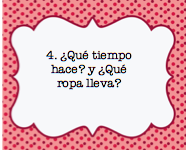Pronunciation in your classroom
Last week, while browsing a Facebook group filled with fabulous language teachers, the topic of pronunciation and teaching the alphabet was brought up. One teacher wanted new ideas for reviewing the alphabet with her students. I loved reading all the different ways in which we are all engaging our students differently in order to get to the same goal: proficiency!
 The thread became a phenomenal list of activities that inspired me. I had been wanting to create some task cards with challenging words for my students and this conversation gave me the push I needed.
The thread became a phenomenal list of activities that inspired me. I had been wanting to create some task cards with challenging words for my students and this conversation gave me the push I needed.So, let me share with you a list of some of the activities that you can use in your classroom as well as my pronunciation task cards.
 Activity 1: Teléfono roto.
Activity 1: Teléfono roto.An oldie but a goodie. Get your students in small groups and hand student 1 a card. Let them spell it to student 2, and 2 spells it to 3 and so on. The last student has to spell it out loud or write it on a piece of paper. They all compare it to the original. Round 2 changes who student 1 is so everyone gets a chance to be at different stages of the line.
 Activity 2: Yo tengo. ¿Quién tiene? Create multiple copies of this set of words. Give each student 2 cards. They can pick one that they have and one they are searching for. Students roam the classroom sharing with others (by spelling) the word they have and the one they need.
Activity 2: Yo tengo. ¿Quién tiene? Create multiple copies of this set of words. Give each student 2 cards. They can pick one that they have and one they are searching for. Students roam the classroom sharing with others (by spelling) the word they have and the one they need.Activity 3: Around the world. My students have enjoyed this one with different topics. Most say that being in the spotlight is a great challenge and makes them work harder. Student 1 and student 2 stand by each other. Word is given. Both get a chance to spell it. Whoever does it correctly moves on to challenge student 3. The student who can be the last one standing is the winner. Second winner can be the student with the higher winning streak. As a way to engage all the students who are no longer in the running to win, have them spell them out on a piece of paper and award them something if they can get the rest of the words right!
 Activity 4: Spelling bee contest. Make it a contest, pick a reward, and have some fun! For students who start losing, ask them to create small groups where they can all practice writing out the word that is given in the challenge and serve as helping judges.
Activity 4: Spelling bee contest. Make it a contest, pick a reward, and have some fun! For students who start losing, ask them to create small groups where they can all practice writing out the word that is given in the challenge and serve as helping judges.Activity 5: Hot potato. My beachballs are always a hit. Make a circle, say the word aloud and have students spell while passing the ball. Student who says something incorrectly is out. Start a "losers" bracket / second group and that way everyone continues to be
challenged.
Activity 6: Quiz, quiz, trade. Students roam the room and find a partner. They quiz them by saying their card aloud. Student 2 then spells it out. Then student 2 quizzes student 1 with their card. After they are done (quiz, quiz), they trade and move on to find new partners! Perfect bell ringer!
Activity 7: Matamoscas. have the words written on your board, or use these cards to display on your smart board or make copies to put on board. Have a second set to give around to students. Select random students to come up to the board and select one of the students on their seats to slowly start spelling out the word on the card they have. The students standing by the board need to hit the correct word being spelled out in order to win.
Activity 8: Relay races. Divide students into smaller groups. Student 1 says word from card to student 2. Student 2 must spell it aloud correctly. Then student 2 then pronounces his card to student 3. Student 3 spells and so on. Team that complete this task in the least amount of time is the winner!


































